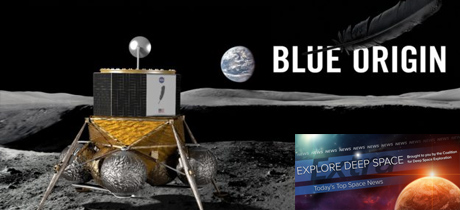In Today’s Deep Space Extra… Russia, Blue Origin announce individual efforts to lead lunar lander capabilities. Russia and China are to discuss space station cooperation.
Human Space Exploration
Russia launches work to create module for landing cosmonauts on Moon
TASS of Russia (7/3): The Energia Rocket and Space Corp., of Russia, has started work on a rocket stage capable of landing and ascending from the lunar surface. Parts of the Russian lander would be assembled at the NASA led Lunar Orbiter Platform-Gateway (LOPG), a human tended lunar orbiting outpost, using the Space Launch System (SLS) and crewed Orion capsule. Assembly of the gateway is to begin in 2022.
Russia, China consider joint space station
Sputnik News of Russia (7/4): Delegates from the Chinese and Russian space agencies are to talk about joint a space station, according to the report. The talks would follow an earlier meeting between president’s Xi and Putin and signed agreements to cooperate in the exploration of the Moon.
Blue Origin targets Moon landing by 2023 as an early step toward lunar settlement
GeekWire.com (7/3): Blue Origin intends to carry out a lunar landing within 5 years to demonstrate capabilities to soft land multi ton payloads, a requirement for future human settlements on the Moon. A company executive outlined the timeline during the late June Space Frontier Foundation’s NewSpace conference in Renton, Washington. Blue is currently working on the descent stage and looking for global partners for the venture.
Space Science
China launches new space science program
Xinhuanet of China (7/4): China on Wednesday announced a new space science program. Themes are to include the origins and evolution of the universe; black holes and gravity waves; the relationship between the solar system and humans.
Meteorite-hunting ship picks up two promising bits from Pacific Ocean seafloor
GeekWire.com (7/3): Multiple science organizations, including NASA, joined to attempt the recovery of a meteorite that was observed in March as it fell into the Pacific Ocean off the coast of Washington state. The search using robotic undersea explorers was to conclude July 4. At least two fragments were recovered.
Approaching green comet explodes
Spaceweather.com (7/4): On July 1, Comet PANSTARRS (C/2017 S3) increased greatly in brightness. Now twice as large as Jupiter, this comet could become visible to the naked eye in August as it nears the sun. Discovered last September, this comet is headed toward the sun from the Oort Cloud.
Many asteroids might be remnants of five destroyed worlds, scientists say
Washington Post (7/3): A study led by a University of Florida scientist suggests the asteroid swarm between Mars and Jupiter may have been created four billion years ago by collisions among as five planetesimals, or planets in the formation stages. The work was published in the journal Nature Astronomy.
Other News
Telescope array will spy on spy satellites, star surfaces and black holes
Science (7/3): New Mexico’s Magdalena Ridge Observatory Interferometer will have the observing capabilities of 10 small high power telescopes to create a powerful U.S. Air Force observatory to study the details of orbiting satellites as well as distant planetary and stellar objects.

